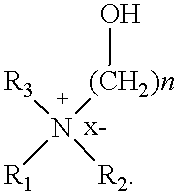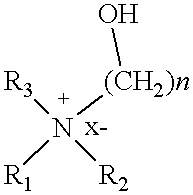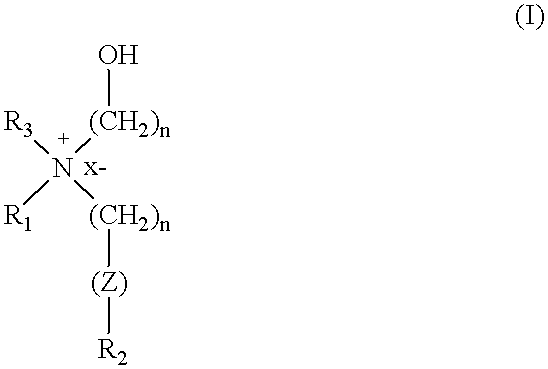Cationic amphiphiles containing N-hydroxyalkyl group for intracellular delivery of biologically active molecules
a cationic amphiphile and biologically active technology, applied in the field of new cationic amphiphilic compounds, can solve the problems of insufficient intracellular uptake procedures, substantial quantities of cationic lipids to be consumed, and the inefficient process of synchronized entry of normal copies of genes into the target cells of patients, so as to achieve the effect of improving the transfection efficiency of novel cationic amphiphiles
- Summary
- Abstract
- Description
- Claims
- Application Information
AI Technical Summary
Benefits of technology
Problems solved by technology
Method used
Image
Examples
example 2
Procedure for the simultaneous preparation of N,N-di-n-hexadecyl-N,N-dihydroxyethylammonium bromide (DHDEAB), amphiphile No 1 and N-n-hexadecyl-N,N-dihydroxyethylammonium bromide (HDEAB), amphiphile No. 2
A mixture of diethanolamine (1 g, 9.5 mmol), n-hexadecyl bromide (2.9 g, 9.5 mmol) and potassium carbonate (1.44 g, 10.5 mmol) was refluxed in methanol for 48 hours. Methanol was removed on a rotatory evaporator and the residue was extracted with chloroform (3.times.100 ml). The combined chloroform extract was filtered repeatedly (3 times) to remove potassium carbonate. Chloroform was removed from the filtrate on a rotary evaporator and the residue was taken in 50 ml 80:15:5 (v / v) acetonitrile: ethyl acetate:methanol. One equivalent of n-hexadecyl bromide (2.9 g, 9.5 mmol) was added and the mixture was refluxed for 56 hours. At this point, an additional equivalent of potassium carbonate (1.44 g, 10.5 mmol) was added and refluxing was continued for another 30 hours. Finally, one more...
example 3
Procedure for preparing N-methyl-N-n-octadecyl-N-oleyl-N-hydroxyethylammonium chloride (MOOHAC), amphiphile No 3.
Step (a). 100 ml dry dichloromethane was cooled to 0.degree. C. and to the cold dichloromethane solution was added 1.9 g of oleyl aldehyde (7.14 mmol), 1.92 g of stearyl amine (7.14 mmol) and 10.9 g of anhydride magnesium sulfate (7.14 mmol). The mixture was kept under stirring for 3 hours while the temperature of the stirred mixture raised gradually from 0.degree. C. to room temperature. The magnesium sulfate was filtered from the reaction mixture and the filtrate was diluted with 50 ml of methanol. The diluted dichloromethane / methanol solution was cooled to 0.degree. C. and to the cold solution, 0.54 g Sodium borohydride (14.0 mmol) was added. The solution was kept stirred for 4 hours during which time the temperature of the reaction mixture gradually raised to room temperature. The reaction mixture was taken in 100 ml chloroform, washed with water (2.times.100 ml), the...
example 4
Procedure for preparing N,N,-di[O-hexadecanoyl]hydroxyethyl-N-hydroxyethyl-N-methylammonium bromide (DOHEMAB), amphiphile 5.
Step (a). Di-O-palmitoylation of N-methyl-diethanolamine was effected following a published protocol [Tundo et al. J. Am. Chem. Soc. 104, 456-461]. Briefly, N-methyldiethanolamine (1 g, 8.39 mmol) was reacted with palmitoyl chloride (5.075 g, 18.5 mmol) in 10 ml dry N,N-dimethylformamide at 0.degree. C. and the temperature was gradually raised to room temperature within a period of 4 hours. The resulting hydrochloride salt of N-methyl-di-O-palmitoylethanolamine was filtered, crystallized from 20 ml of dry ether. Finally, recrystallization from 20 ml 5:15 (v / v) methanol:ethyl acetate afforded 3.8 g of the pure hydrochloride intermediate in 68% yield.
Step (b). The recrystallized hydrochloride salt (200 mg) was stirred for 5 minutes in a dichlorometlhane (10 ml) / 1.0 M aqueous NaOH (10 ml) biphasic system. The top aqueous layer was discarded and the lower organic l...
PUM
| Property | Measurement | Unit |
|---|---|---|
| sonic power | aaaaa | aaaaa |
| volume | aaaaa | aaaaa |
| volume | aaaaa | aaaaa |
Abstract
Description
Claims
Application Information
 Login to View More
Login to View More - R&D
- Intellectual Property
- Life Sciences
- Materials
- Tech Scout
- Unparalleled Data Quality
- Higher Quality Content
- 60% Fewer Hallucinations
Browse by: Latest US Patents, China's latest patents, Technical Efficacy Thesaurus, Application Domain, Technology Topic, Popular Technical Reports.
© 2025 PatSnap. All rights reserved.Legal|Privacy policy|Modern Slavery Act Transparency Statement|Sitemap|About US| Contact US: help@patsnap.com



